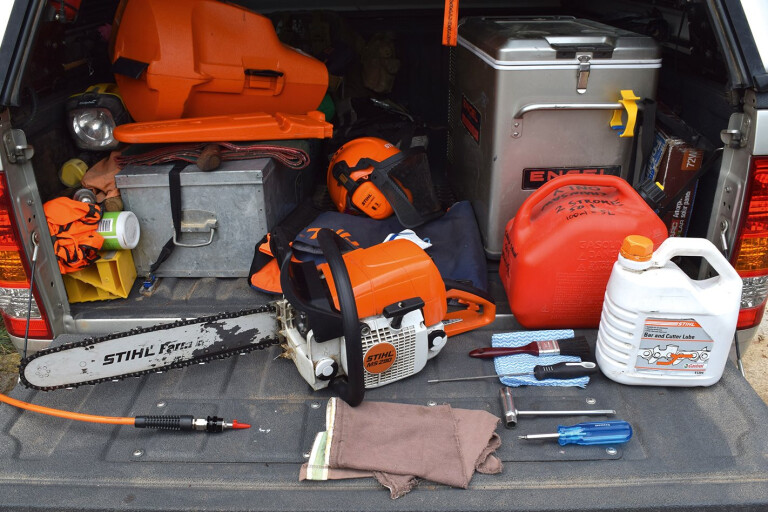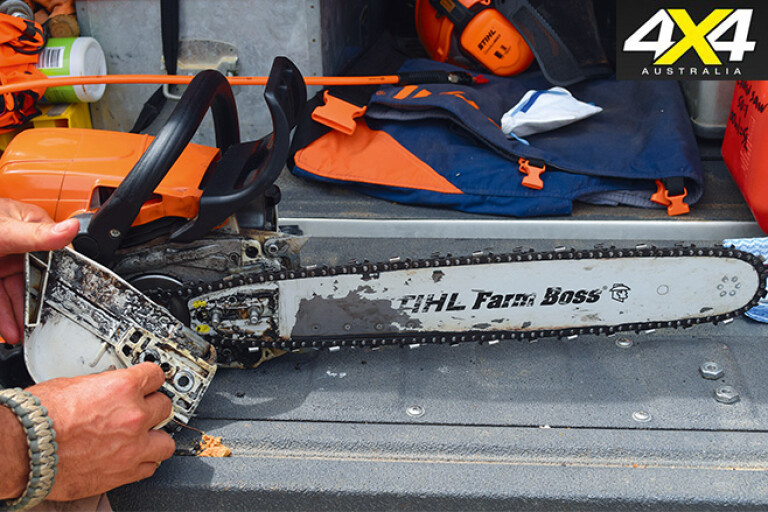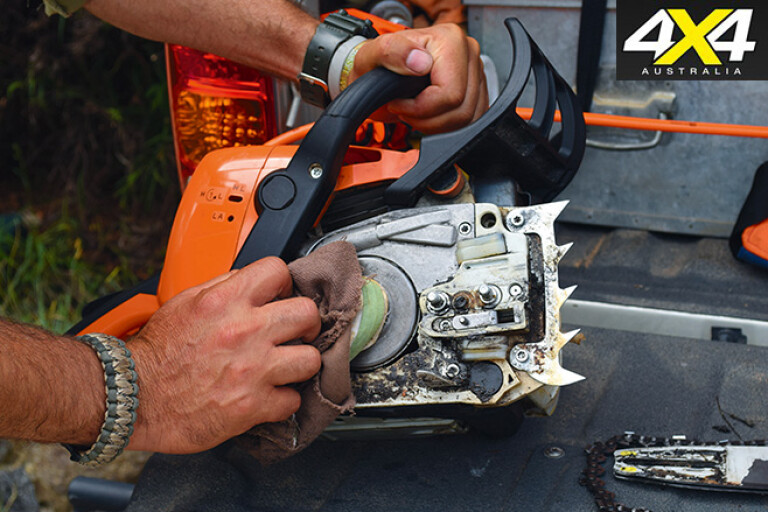
We all take our rigs to a trusted auto mechanic for servicing because we know it’s the right thing to do.
After all, a well-maintained vehicle will have a long life, and a well-tuned engine will use less fuel, produce more power and will release less emissions.
We also know that a mid-service lube and oil change is a good idea because lubricants lose their effectiveness over time and all moving parts must be lubricated. Otherwise we get unnecessary wear and tear from things including: inadequate engine temperatures during city driving; climatic conditions; cold starts; and towing.
So if we look after our ‘big engine’, why do some of us ignore the needs of the small engine that often lives in the back tray or is strapped to your roof racks? That’s right; we’re talking about the little engine attached to your chainsaw. It needs some love and attention, too.

We use chainsaws for the odd job around the house, to cut fire wood when out camping (or at home), for fencing jobs and – more importantly – to clear a blocked track. When it’s time to leave an area because of a weather warning, or you’re evacuating your campsite because of a medical incident, you need to be confident that your chainsaw is ready to face whatever challenges you’re up against. It needs to start – first time.
So why is it that so often, when we’re out on the track, someone grabs their chainsaw to deal with a branch or tree, only to find that the little bugger fails to start? Normally it’s bad fuel, but sometimes it’s lack of maintenance.
Common Faults in Storage
Most of us tend to pull out the chainsaw only when we’re packing for a big trip. This means that, for the rest of the time, it’s probably sitting in the shed, neglected. If this is the sort of life you’re offering your chainsaw, the least you can do is store it off the ground.
If you simply leave it lying around on the ground, or on a cement floor, moisture will inevitably wick through the ground. The result can be as simple as surface rust on the bar and chain, or it could even be as bad as engine seizure.
Other things to remember when storing your chainsaw are to:
Make sure the chain and bar oil reservoir remain full. This helps to prevent moisture from building up.
Make sure you change your fuel every two months regardless of whether you’ve used your chainsaw. Fuel goes off after this time. Specifically, it will ‘gum up’ and affect your fuel line and system.

Start your chainsaw at least twice a year. This achieves two things. First, it ensures the engine will not seize. It also practices you in how to start the chainsaw, so that, when you do finally need it, you don’t inadvertently flood the engine through lack of familiarity.
If you know that your chainsaw is going to be sitting around unused for more than a couple of months, empty the fuel tank entirely and store it dry.
To do this, start the chainsaw to warm up the engine. Then stop it, drain the fuel out (keep it in a container to one side, you’ll need it later) and then start the saw until it stalls (this stops the spark plug from becoming ‘wet fouled’).
Pre-use Routine
Pre-use inspections should be carried out with any piece of equipment and your chainsaw is no different. Before you pull the starter cord remember to:
Check the condition of your personal protective equipment (PPE) and put it on.
Visually inspect switches, throttle control, pull starter cord, etc.
Verify all guards are secure and function correctly.
Verify the chain-brake functions.
Ensure saw chain and guide bar are in good condition.
Check that fuel and oil are full.
Repair any identified deficiencies before proceeding further.
Home Servicing
If you’re using your chainsaw regularly, you should be servicing it at least once a week. And servicing won’t take long. But if your chainsaw is sitting idle most of the time, make sure you give yourself a couple of hours to properly service it. You’ll need to factor this in to the time that you set aside to prepare for a trip away.

Cleaning – birds do it, bees do it, and even educated fleas do it. With a chain saw, cleaning starts with a piece of rag, a stiff paint brush and a source of air. First, wipe down all external surfaces and blow out any air from the chainsaw’s exterior including the engine cooling fins. Then remove the chain sprocket cover and brush out all of the crud.
Blow out any excess deposits with air. Wipe down all external components including the bar and chain with the old fuel saved when emptying the tank. People commonly overlook the chain/bar oil hole and passages. Make sure you blow these clear with air too.
Clean or replace the air filter – it’s important to clean or replace the air filter regularly. First, carefully remove the filter, trying not to dislodge dust and muck that could fall into the intake manifold. Place some ‘Chux’ cloth or equivalent, into the intake recess and the openings of the filter. Then clean the detached air filter with warm soapy water before rinsing it with clean water. Allow it to dry before re-installing.

Fuel filter – yes, chainsaws have one. And if you’ve left your chainsaw on the shelf for a year, or have been feeding it the spare left over fuel from yesteryear, you should probably replace it.
Spark plugs – should be replaced yearly. Dirty and worn spark plugs can reduce your chainsaw’s starting and cutting performance. If the plug is dirty, use a carburettor cleaner and fine sandpaper to clean it, then set the gap to specification. If the plug is worn, replace it (you should always carry a spare).
Drive sprocket – with heavy use, you may need to change these every year. So it may be handy to have a spare on hand. After all, it’s only held in by a ‘C’ clip, so changing it is relatively simple.

Sharpening the chain – keeping your chain sharp is the most important part of maintaining your chainsaw. A blunt chain, caused by contact with soil, rocks and general use, will simply rotate and burn the wood rather than cutting it. You’ll know your chain is blunt when you need to apply heavy force to push your saw when cutting.
Chains can be professionally sharpened. Alternatively, you can easily do it yourself using a correct-sized sharpening file. Push it horizontally forward through each cleat – then lift – and repeat two more times. To help the process, consider utilising a vice to clamp the bar, locking the chain by pushing the hand guard forward.
Chain tension – general use stretches your chain, which, if not tightened, may come off during use. To adjust, loosen the guide bar’s retaining nuts – located on the side of the saw where the guide bar attaches to the motor. Next, turn the chain tension adjustment screw so that the chain is tight but you can still move it easily with your gloved hand. Once this is done, replace the guide-bar retaining nuts. If your chain doesn’t tighten, it may be time to replace it.

Lubrication – once your chainsaw is re-assembled, find a clean surface or a piece of newspaper and accelerate the saw a few times pointed in its general direction. Oil should spray onto the surface. If it doesn’t, check that the oil reservoir is full. Also check that the oil passages and holes on the guide bar are clean. If the oiling system still doesn’t work, it’s time to take it to an authorised service centre.
Other tips
Routinely reverse the chain bar, top to bottom, to avoid wear on one side.
Don’t operate the chainsaw with the air intake on the ground as this will draw foreign particles into the motor area and damage the motor.
If you notice that you’ve inadvertently knocked dirt or other crud into the oil reservoir while re-fuelling: drain the contaminated oil into an approved container; let the oil drain overnight by gravity; rinse the reservoir with fuel; let it air dry; and then blow out with air.
The Bottom Line
Whether you have an electric or a petrol chainsaw, it’s important to undertake general maintenance and regular servicing to achieve optimal performance and longevity of your saw. Proper maintenance will not only prolong the life of your chainsaw, it will also make your work a lot easier.

COMMENTS